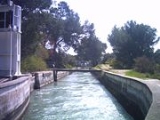
Canal de Marseille
Encyclopedia
The Canal de Marseille is a major source of drinking water
for the city of Marseille
, the largest city in Provence
, France
. The canal
's length along its main artery is 80 kilometres (50 mi) - though there is an additional 160 kilometres (99 mi) of minor arteries - and it services the entire district of Marseille. It took fifteen years of construction under the direction of engineer Franz Mayor de Montricher, and opened on July 8, 1849. It represents a significant achievement in nineteenth century engineering, combining bridges, tunnels, and reservoirs to create a canal over mountainous terrain. Until 1970, it was almost the sole water source for Marseille and currently provides two-thirds of the city's drinking water
.
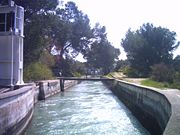
, located along the hilly Mediterranean
seafront is only crossed by one irregular river, the Heaveaune River, and its tributary, the Jarret River. The waters were canalized in the 14th century, but over time became an open sewer
. Water quality continued to decline and the distribution suffered due to lack of maintenance on the network.
Further, since the river suffered from a weak flow droughts were devastating to the region. For example, in 1834 the river nearly dried out completely and only 1 litres (1 US qt) was available per person, per day. In the 1830s, Marseille began to experience rapid population growth and in 1832-1835 epidemics of cholera
convinced elected officials to act to restore health and ensure an appropriate quantity of water for the city.
 This cholera epidemic caused the deaths of approximately 100,000 people throughout France. Originally of Asian origin, the disease spread along the Ganges valley in 1826, then the Caspian
This cholera epidemic caused the deaths of approximately 100,000 people throughout France. Originally of Asian origin, the disease spread along the Ganges valley in 1826, then the Caspian
and Volga in 1829. In 1830, the disease overtook Moscow
and Poland
, and Hamburg
in 1831. In March 1832, cholera reached Paris
, where 18,000 died, and decimated the population in Haute-Provence. In July 1833, the epidemic reached Marseille. By December 1834, 865 were dead and in 1835 the death toll numbered 2,500.
These epidemics revived the residents' fears of the Great Plague of Marseille
, which had occurred a little more than a century before and caused around 100,000 deaths. In July 1833, 30,000 Marseillaise gathered in the city center to protest the sanitary conditions..
Maximin-Dominica Consolat, mayor of Marseille from 1832 to 1843, decided in 1834 to improve conditions, "no matter what it costs." The decision was made to bring in water from the nearest large river, the Durance
. However, the distance was substantial and the river was separated from Marseille by mountain chains (chaîne des Côtes, plateau de l'Arbois, massif de l'Étoile). The plan called for water to be captured quite high on the Durance and thus harness gravity to overcome the mountainous terrain and arrive in Marseille at the highest point of the city, Saint-Antoine (150 metres (492 ft)). Hence allowing water service to the entire community.
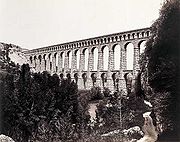
 Indeed, a major challenge faced was passing the canal through the valley of the Arc, which has an altitude of less than 100 metres (328 ft) between Aix-en-Provence
Indeed, a major challenge faced was passing the canal through the valley of the Arc, which has an altitude of less than 100 metres (328 ft) between Aix-en-Provence
and the Etang de Berre
. The project's head engineer Franz Mayor of Montricher, refused the proposal of a bridge-trap
and decided to make an aqueduct
in which the plateaus along the valley were closest at 400 metres (1,312 ft): this would be the Roquefavour Aqueduct at Ventabren
, inspired by the Roman architectural work Pont du Gard
. Since, the aqueduc Roquefavour, with a length of 393 metres (1,289 ft) has been regarded as one of the main tourist attractions in the Aix-en-Provence region.
The canal is mostly constructed of concrete
, although some portions are created from stone
or brick
. The canal's flow is 10 cubic metres (10 kl) per second, the slope is 0.36 metres (1.2 ft) per 1 kilometre (0.621372736649807 mi). The width at the top is 9.4 metres (30.8 ft), and the width at the basin
is 3 metres (10 ft).
Water began flowing through the partially unfinished canal on November 19, 1849 in Marseille. Between 1854 and 1869, 77 kilometres (48 mi) of pipes, tanks, and basins were constructed, allowing access to water throughout Marseille and the neighboring communes of Plan-de-Cuques
, Allauch
, and Aubagne
.
Despite the doubling of the population in the next forty years, Marseille in 1876 had over thirty times more water per capita: 370 litres (98 US gal) for domestic usage and 660 litres (174 US gal) for industrial activities, daily.
 The initial intake of the canal from the Durance
The initial intake of the canal from the Durance
was at the bridge "Pertius" in the Vaucluse
at an elevation of 185 metres (607 ft) and 50 kilometres (31 mi) from Marseille. From there, the canal travels west to Lew Puy-Sainte-Réparade, then northwest to Saint-Estève-Janson. Then the canal continues north-west to the bridge Cadenet
, where it feeds the pondSt. Christopher.
 The route then clings to the hills, passes over La Roque-d'Anthéron
The route then clings to the hills, passes over La Roque-d'Anthéron
and Charleval, and then exits the Durance and EDF
, turns to the south and enters a long tunnel under the west end of the chaîne des Côtes, a mountain range.
After Lambesc
, the canal's path becomes more complex: many bridges and tunnels are required to travel the valleys and near Coudoux
. The canal bypasses the hill Ventabren
, and comes to the Arc where it enters the aqueduct Roquefavour. Near this area, the Paris-Marseille line of the TGV
passes and the railway's viaducts have been designed to harmonize with the aqueduct.
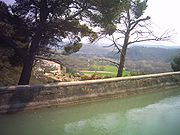 A 3 kilometres (2 mi) tunnel crosses under the southern Arbois plain until the canal enters the treatment plant Giraudets. Finally, the water flows into a 2 kilometres (1 mi) entrance lead into Marseille.
A 3 kilometres (2 mi) tunnel crosses under the southern Arbois plain until the canal enters the treatment plant Giraudets. Finally, the water flows into a 2 kilometres (1 mi) entrance lead into Marseille.
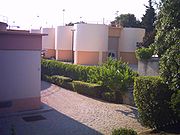 Today, the canal is no longer the sole water source for Marseille. The Canal de Provence, an almost completely underground network of canals from the Verdon
Today, the canal is no longer the sole water source for Marseille. The Canal de Provence, an almost completely underground network of canals from the Verdon
River built in the 1970s now brings water to not only Marseille, but also Aix-en-Provence
and Toulon
. Today, this water amounts for approximately two-thirds of the water brought into Marseille, the remaining third comes from the Verdon through Provence.. Both sources are interconnected.
The water is treated in two water treatment
facilities, Sainte-Marthe and Saint-Barnabé. The main operations performed by the treatment facilities are pre-chlorination
, clarification
by flocculation
with a coagulant
, sand filtration and disinfection with ozone
and chlorine
. In 2006 the health authority of Marseille carried out a number of tests on the water quality determining that the canal's water conformed to all required norms. In 2009 a young mother & her baby where found dead in their apartment: the culprit was chlorine gas from the water supply. This led to a city-wide survey of the gasses in system, although not before others where admitted to hospital from all over the city.
was named the first president.
Since then SEEM, held equally by Veolia Environnement and Lyonnais des eaux, has controlled the canal's operation.
The canal's offshoot irrigation ditches are controlled by the aygadiers, who have the right to cross private property in order to assist in the repair and operation of the canal. The focus of SEEM and the aygadiers has recently been on centring the use of the canal on drinking water. Therefore, irrigation rights are not being renewed and the municipality is providing pressured-water instead.
Furthermore, the canal authority employs 15 chercheurs de fuite (French
: literally "searchers of leaks") who are responsible for finding leaks in the distribution system. As assistance, the chercheurs utilize geophone
s which amply sound up to 400 times. These employees have allowed the efficiency of the canal to raise to 85%..
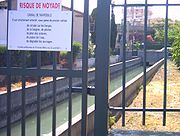 The canal outside of Marseille proper is open to the air and can be followed along the road, except for the subterranean portions. However, within the city limits, efforts are being made to cover the canal. These action is due to various safety concerns, including the unpredictable nature of the water's flow following valve openings and the steep and slippery walls.
The canal outside of Marseille proper is open to the air and can be followed along the road, except for the subterranean portions. However, within the city limits, efforts are being made to cover the canal. These action is due to various safety concerns, including the unpredictable nature of the water's flow following valve openings and the steep and slippery walls.
Moreover, there are ongoing campaigns aimed at adding fences, lifelines, and barriers, and posting warning signs along the canal's route
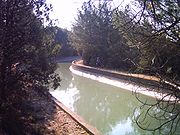 The canal passes through many picturesque regions of Provence and contains bicycle and walking paths along its route.
The canal passes through many picturesque regions of Provence and contains bicycle and walking paths along its route.
Notable remarkable sites include:
refers to the canal in his memoirs, Le Château de ma mère, where his father is given a key which enables him to enter the canal through private property and thus shorten his journey. However, the truth of this claim is doubted.
Drinking water
Drinking water or potable water is water pure enough to be consumed or used with low risk of immediate or long term harm. In most developed countries, the water supplied to households, commerce and industry is all of drinking water standard, even though only a very small proportion is actually...
for the city of Marseille
Marseille
Marseille , known in antiquity as Massalia , is the second largest city in France, after Paris, with a population of 852,395 within its administrative limits on a land area of . The urban area of Marseille extends beyond the city limits with a population of over 1,420,000 on an area of...
, the largest city in Provence
Provence
Provence ; Provençal: Provença in classical norm or Prouvènço in Mistralian norm) is a region of south eastern France on the Mediterranean adjacent to Italy. It is part of the administrative région of Provence-Alpes-Côte d'Azur...
, France
France
The French Republic , The French Republic , The French Republic , (commonly known as France , is a unitary semi-presidential republic in Western Europe with several overseas territories and islands located on other continents and in the Indian, Pacific, and Atlantic oceans. Metropolitan France...
. The canal
Canal
Canals are man-made channels for water. There are two types of canal:#Waterways: navigable transportation canals used for carrying ships and boats shipping goods and conveying people, further subdivided into two kinds:...
's length along its main artery is 80 kilometres (50 mi) - though there is an additional 160 kilometres (99 mi) of minor arteries - and it services the entire district of Marseille. It took fifteen years of construction under the direction of engineer Franz Mayor de Montricher, and opened on July 8, 1849. It represents a significant achievement in nineteenth century engineering, combining bridges, tunnels, and reservoirs to create a canal over mountainous terrain. Until 1970, it was almost the sole water source for Marseille and currently provides two-thirds of the city's drinking water
Drinking water
Drinking water or potable water is water pure enough to be consumed or used with low risk of immediate or long term harm. In most developed countries, the water supplied to households, commerce and industry is all of drinking water standard, even though only a very small proportion is actually...
.

History
MarseilleMarseille
Marseille , known in antiquity as Massalia , is the second largest city in France, after Paris, with a population of 852,395 within its administrative limits on a land area of . The urban area of Marseille extends beyond the city limits with a population of over 1,420,000 on an area of...
, located along the hilly Mediterranean
Mediterranean Sea
The Mediterranean Sea is a sea connected to the Atlantic Ocean surrounded by the Mediterranean region and almost completely enclosed by land: on the north by Anatolia and Europe, on the south by North Africa, and on the east by the Levant...
seafront is only crossed by one irregular river, the Heaveaune River, and its tributary, the Jarret River. The waters were canalized in the 14th century, but over time became an open sewer
Sanitary sewer
A sanitary sewer is a separate underground carriage system specifically for transporting sewage from houses and commercial buildings to treatment or disposal. Sanitary sewers serving industrial areas also carry industrial wastewater...
. Water quality continued to decline and the distribution suffered due to lack of maintenance on the network.
Further, since the river suffered from a weak flow droughts were devastating to the region. For example, in 1834 the river nearly dried out completely and only 1 litres (1 US qt) was available per person, per day. In the 1830s, Marseille began to experience rapid population growth and in 1832-1835 epidemics of cholera
Cholera
Cholera is an infection of the small intestine that is caused by the bacterium Vibrio cholerae. The main symptoms are profuse watery diarrhea and vomiting. Transmission occurs primarily by drinking or eating water or food that has been contaminated by the diarrhea of an infected person or the feces...
convinced elected officials to act to restore health and ensure an appropriate quantity of water for the city.

Caspian Sea
The Caspian Sea is the largest enclosed body of water on Earth by area, variously classed as the world's largest lake or a full-fledged sea. The sea has a surface area of and a volume of...
and Volga in 1829. In 1830, the disease overtook Moscow
Moscow
Moscow is the capital, the most populous city, and the most populous federal subject of Russia. The city is a major political, economic, cultural, scientific, religious, financial, educational, and transportation centre of Russia and the continent...
and Poland
Poland
Poland , officially the Republic of Poland , is a country in Central Europe bordered by Germany to the west; the Czech Republic and Slovakia to the south; Ukraine, Belarus and Lithuania to the east; and the Baltic Sea and Kaliningrad Oblast, a Russian exclave, to the north...
, and Hamburg
Hamburg
-History:The first historic name for the city was, according to Claudius Ptolemy's reports, Treva.But the city takes its modern name, Hamburg, from the first permanent building on the site, a castle whose construction was ordered by the Emperor Charlemagne in AD 808...
in 1831. In March 1832, cholera reached Paris
Paris
Paris is the capital and largest city in France, situated on the river Seine, in northern France, at the heart of the Île-de-France region...
, where 18,000 died, and decimated the population in Haute-Provence. In July 1833, the epidemic reached Marseille. By December 1834, 865 were dead and in 1835 the death toll numbered 2,500.
These epidemics revived the residents' fears of the Great Plague of Marseille
Great Plague of Marseille
The Great Plague of Marseille was the last of the significant European outbreaks of bubonic plague. Arriving in Marseille, France in 1720, the disease killed 100,000 people in the city and the surrounding provinces. However, Marseille recovered quickly from the plague outbreak. Economic activity...
, which had occurred a little more than a century before and caused around 100,000 deaths. In July 1833, 30,000 Marseillaise gathered in the city center to protest the sanitary conditions..
Maximin-Dominica Consolat, mayor of Marseille from 1832 to 1843, decided in 1834 to improve conditions, "no matter what it costs." The decision was made to bring in water from the nearest large river, the Durance
Durance
The Durance is a major river in south-eastern France.Its source is in the south-western Alps, in Montgenèvre ski resort near Briançon and it flows south-west through the following départements and cities:* Hautes-Alpes: Briançon, Embrun.* Alpes-de-Haute-Provence: Sisteron, Manosque.* Vaucluse:...
. However, the distance was substantial and the river was separated from Marseille by mountain chains (chaîne des Côtes, plateau de l'Arbois, massif de l'Étoile). The plan called for water to be captured quite high on the Durance and thus harness gravity to overcome the mountainous terrain and arrive in Marseille at the highest point of the city, Saint-Antoine (150 metres (492 ft)). Hence allowing water service to the entire community.
Construction
The building of the canal took 15 years, from 1839–1854 and covered 80 kilometres (50 mi) of which 17 kilometres (11 mi) were underground. The canal also traverses 18 bridges.

Aix-en-Provence
Aix , or Aix-en-Provence to distinguish it from other cities built over hot springs, is a city-commune in southern France, some north of Marseille. It is in the region of Provence-Alpes-Côte d'Azur, in the département of Bouches-du-Rhône, of which it is a subprefecture. The population of Aix is...
and the Etang de Berre
Étang de Berre
The Étang de Berre is a body of water adjacent to the Mediterranean, about 25km north-west of Marseille.-Geography:Created by the rise in water levels at the end of the last ice age, this small inland sea is composed of...
. The project's head engineer Franz Mayor of Montricher, refused the proposal of a bridge-trap
Trap (plumbing)
In plumbing, a trap is a U-, S-, or J-shaped pipe located below or within a plumbing fixture. An S-shaped trap is also known as the S-bend invented by Alexander Cummings in 1775 but became known as the U-bend following the introduction of the U-shaped trap by Thomas Crapper in 1880. The new U-bend...
and decided to make an aqueduct
Aqueduct
An aqueduct is a water supply or navigable channel constructed to convey water. In modern engineering, the term is used for any system of pipes, ditches, canals, tunnels, and other structures used for this purpose....
in which the plateaus along the valley were closest at 400 metres (1,312 ft): this would be the Roquefavour Aqueduct at Ventabren
Ventabren
Ventabren is a commune in the Bouches-du-Rhône department in southern France.-Location:It is close to Aix-en-Provence, and only away from Coudoux and Velaux.-History:...
, inspired by the Roman architectural work Pont du Gard
Pont du Gard
The Pont du Gard is a notable ancient Roman aqueduct bridge that crosses the Gard River in southern France. It is part of a long aqueduct that runs between Uzès and Nîmes in the South of France. It is located in Vers-Pont-du-Gard near Remoulins, in the Gard département...
. Since, the aqueduc Roquefavour, with a length of 393 metres (1,289 ft) has been regarded as one of the main tourist attractions in the Aix-en-Provence region.
The canal is mostly constructed of concrete
Concrete
Concrete is a composite construction material, composed of cement and other cementitious materials such as fly ash and slag cement, aggregate , water and chemical admixtures.The word concrete comes from the Latin word...
, although some portions are created from stone
Rock (geology)
In geology, rock or stone is a naturally occurring solid aggregate of minerals and/or mineraloids.The Earth's outer solid layer, the lithosphere, is made of rock. In general rocks are of three types, namely, igneous, sedimentary, and metamorphic...
or brick
Brick
A brick is a block of ceramic material used in masonry construction, usually laid using various kinds of mortar. It has been regarded as one of the longest lasting and strongest building materials used throughout history.-History:...
. The canal's flow is 10 cubic metres (10 kl) per second, the slope is 0.36 metres (1.2 ft) per 1 kilometre (0.621372736649807 mi). The width at the top is 9.4 metres (30.8 ft), and the width at the basin
Canal basin
A canal basin is an expanse of waterway alongside or at the end of a canal, and wider than the canal, constructed to allow boats to moor or unload cargo without impeding the progress of other traffic, and to allow room for turning, thus serving as a winding hole...
is 3 metres (10 ft).
Water began flowing through the partially unfinished canal on November 19, 1849 in Marseille. Between 1854 and 1869, 77 kilometres (48 mi) of pipes, tanks, and basins were constructed, allowing access to water throughout Marseille and the neighboring communes of Plan-de-Cuques
Plan-de-Cuques
Plan-de-Cuques is a commune northeast of Marseille in the department of Bouches-du-Rhône in the Provence-Alpes-Côte d'Azur region of France.-Population:The inhabitants are called Plan-de-Cuquois.-References:*...
, Allauch
Allauch
Allauch is a French commune situated east of Marseille in the department of Bouches-du-Rhône in the Provence-Alpes-Côte d'Azur region of France. Its inhabitants are called Allaudians.- Location :...
, and Aubagne
Aubagne
Aubagne is a commune located east of Marseille in the Bouches-du-Rhône department in southern France.The French Foreign Legion has its headquarters there...
.
Despite the doubling of the population in the next forty years, Marseille in 1876 had over thirty times more water per capita: 370 litres (98 US gal) for domestic usage and 660 litres (174 US gal) for industrial activities, daily.
Through the Bouches-du-Rhone

Durance
The Durance is a major river in south-eastern France.Its source is in the south-western Alps, in Montgenèvre ski resort near Briançon and it flows south-west through the following départements and cities:* Hautes-Alpes: Briançon, Embrun.* Alpes-de-Haute-Provence: Sisteron, Manosque.* Vaucluse:...
was at the bridge "Pertius" in the Vaucluse
Vaucluse
The Vaucluse is a department in the southeast of France, named after the famous spring, the Fontaine-de-Vaucluse.- History :Vaucluse was created on 12 August 1793 out of parts of the departments of Bouches-du-Rhône, Drôme, and Basses-Alpes...
at an elevation of 185 metres (607 ft) and 50 kilometres (31 mi) from Marseille. From there, the canal travels west to Lew Puy-Sainte-Réparade, then northwest to Saint-Estève-Janson. Then the canal continues north-west to the bridge Cadenet
Cadenet
Cadenet is a commune in the Vaucluse department in the Provence-Alpes-Côte d'Azur region in southeastern France.-Jewish community:Like all places situated along the river Durance, Cadenet had a Jewish community in the Middle Ages...
, where it feeds the pondSt. Christopher.

La Roque-d'Anthéron
La Roque-d'Anthéron is a commune in the Bouches-du-Rhône department in southern France. Silvacane Abbey, a former Cistercian monastery, is located near La Roque-d'Anthéron.-Population:-References:*...
and Charleval, and then exits the Durance and EDF
Électricité de France
Électricité de France S.A. is the second largest French utility company. Headquartered in Paris, France, with €65.2 billion in revenues in 2010, EDF operates a diverse portfolio of 120,000+ megawatts of generation capacity in Europe, Latin America, Asia, the Middle East and Africa.EDF is one of...
, turns to the south and enters a long tunnel under the west end of the chaîne des Côtes, a mountain range.
After Lambesc
Lambesc
Lambesc is a commune in the Bouches-du-Rhône department in the Provence-Alpes-Cote d'Azur region in southern France.Lambesc is located in the heart of Provence at the foot of the Côtes mountain range, near the Alpilles. The village has a strong historical and cultural heritage, being home to the...
, the canal's path becomes more complex: many bridges and tunnels are required to travel the valleys and near Coudoux
Coudoux
Coudoux is a commune in the Bouches-du-Rhône department in southern France.-Location:It is away from Aix-en-Provence, away from Salon-de-Provence, and nearly away from Marseille...
. The canal bypasses the hill Ventabren
Ventabren
Ventabren is a commune in the Bouches-du-Rhône department in southern France.-Location:It is close to Aix-en-Provence, and only away from Coudoux and Velaux.-History:...
, and comes to the Arc where it enters the aqueduct Roquefavour. Near this area, the Paris-Marseille line of the TGV
TGV
The TGV is France's high-speed rail service, currently operated by SNCF Voyages, the long-distance rail branch of SNCF, the French national rail operator....
passes and the railway's viaducts have been designed to harmonize with the aqueduct.

Water Quality

Verdon
-Several places in the United States:*Verdon Township, Aitkin County, Minnesota*Verdon, Nebraska*Verdon, South Dakota-Name or part of the name of several communes in France:* Verdon, in the Dordogne département* Verdon, in the Marne département...
River built in the 1970s now brings water to not only Marseille, but also Aix-en-Provence
Aix-en-Provence
Aix , or Aix-en-Provence to distinguish it from other cities built over hot springs, is a city-commune in southern France, some north of Marseille. It is in the region of Provence-Alpes-Côte d'Azur, in the département of Bouches-du-Rhône, of which it is a subprefecture. The population of Aix is...
and Toulon
Toulon
Toulon is a town in southern France and a large military harbor on the Mediterranean coast, with a major French naval base. Located in the Provence-Alpes-Côte-d'Azur region, Toulon is the capital of the Var department in the former province of Provence....
. Today, this water amounts for approximately two-thirds of the water brought into Marseille, the remaining third comes from the Verdon through Provence.. Both sources are interconnected.
The water is treated in two water treatment
Water treatment
Water treatment describes those processes used to make water more acceptable for a desired end-use. These can include use as drinking water, industrial processes, medical and many other uses. The goal of all water treatment process is to remove existing contaminants in the water, or reduce the...
facilities, Sainte-Marthe and Saint-Barnabé. The main operations performed by the treatment facilities are pre-chlorination
Chlorination
Chlorination is the process of adding the element chlorine to water as a method of water purification to make it fit for human consumption as drinking water...
, clarification
Clarification
In journalism, a clarification is used to make a statement in a published story more clear. It refers to a statement in a story that, while factually correct, may be subject to a misunderstanding or unfair assumption....
by flocculation
Flocculation
Flocculation, in the field of chemistry, is a process wherein colloids come out of suspension in the form of floc or flakes by the addition of a clarifying agent. The action differs from precipitation in that, prior to flocculation, colloids are merely suspended in a liquid and not actually...
with a coagulant
Coagulant
Coagulant can refer to:* flocculation* coagulation agent...
, sand filtration and disinfection with ozone
Ozone
Ozone , or trioxygen, is a triatomic molecule, consisting of three oxygen atoms. It is an allotrope of oxygen that is much less stable than the diatomic allotrope...
and chlorine
Chlorine
Chlorine is the chemical element with atomic number 17 and symbol Cl. It is the second lightest halogen, found in the periodic table in group 17. The element forms diatomic molecules under standard conditions, called dichlorine...
. In 2006 the health authority of Marseille carried out a number of tests on the water quality determining that the canal's water conformed to all required norms. In 2009 a young mother & her baby where found dead in their apartment: the culprit was chlorine gas from the water supply. This led to a city-wide survey of the gasses in system, although not before others where admitted to hospital from all over the city.
Administration
The canal was operated by the city of Marseille from 1849 to 1941. However, following the destructive fires of November 1938, in which 73 people died, the city government was put under trusteeship, and due to this, the operation of the canal was entrusted to the (SEEM) (Society for the study of the Marseille Water) and Raoul Dautry, who had assisted in the creation of the SNCFSNCF
The SNCF , is France's national state-owned railway company. SNCF operates the country's national rail services, including the TGV, France's high-speed rail network...
was named the first president.
Since then SEEM, held equally by Veolia Environnement and Lyonnais des eaux, has controlled the canal's operation.
Support and maintenance
Upon entering the treatment facility at Sainte-Marthe in the 14th arrondissement, the canal water is filtered at the le bassin du Merlan before exiting the structure to enter the distribution network of Marseille. However, the canal does not only serve sanitary purposes. Historically, the structure assisted in irrigating fields for farmers and gardeners and greatly boosted the growth of gardening in the district.The canal's offshoot irrigation ditches are controlled by the aygadiers, who have the right to cross private property in order to assist in the repair and operation of the canal. The focus of SEEM and the aygadiers has recently been on centring the use of the canal on drinking water. Therefore, irrigation rights are not being renewed and the municipality is providing pressured-water instead.
Furthermore, the canal authority employs 15 chercheurs de fuite (French
French language
French is a Romance language spoken as a first language in France, the Romandy region in Switzerland, Wallonia and Brussels in Belgium, Monaco, the regions of Quebec and Acadia in Canada, and by various communities elsewhere. Second-language speakers of French are distributed throughout many parts...
: literally "searchers of leaks") who are responsible for finding leaks in the distribution system. As assistance, the chercheurs utilize geophone
Geophone
The term geophone derives from the Greek word "geo" meaning "earth" and "phone" meaning "sound".A geophone is a device which converts ground movement into voltage, which may be recorded at a recording station...
s which amply sound up to 400 times. These employees have allowed the efficiency of the canal to raise to 85%..
Security

Moreover, there are ongoing campaigns aimed at adding fences, lifelines, and barriers, and posting warning signs along the canal's route
As tourist site and cultural attraction

Notable remarkable sites include:
- The aqueduc de Roquefavour, near Aix-en-Provence ;
- The palais Longchamp, an historic monument in the center of Marseille ;
- The réservoir de Sainte-Marthe ;
- The banks of the canal along the Plateau d'Arbois.
Marcel Pagnol
French novelist Marcel PagnolMarcel Pagnol
Marcel Pagnol was a French novelist, playwright, and filmmaker. In 1946, he became the first filmmaker elected to the Académie Française.-Biography:...
refers to the canal in his memoirs, Le Château de ma mère, where his father is given a key which enables him to enter the canal through private property and thus shorten his journey. However, the truth of this claim is doubted.

